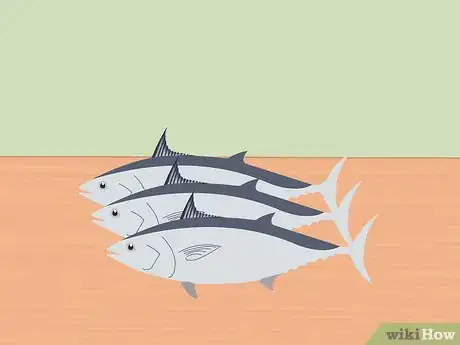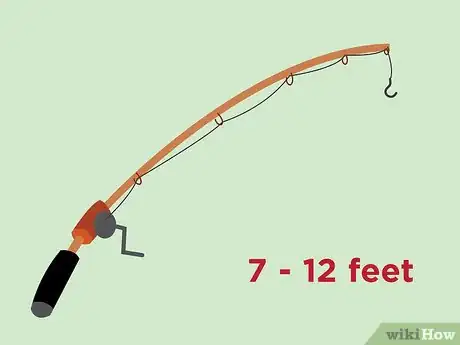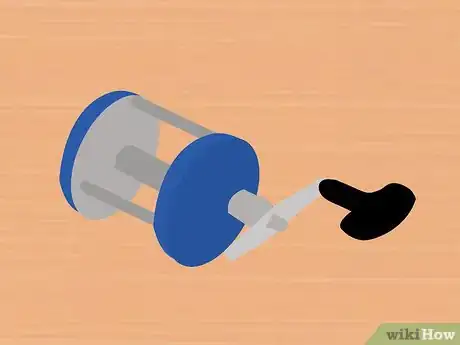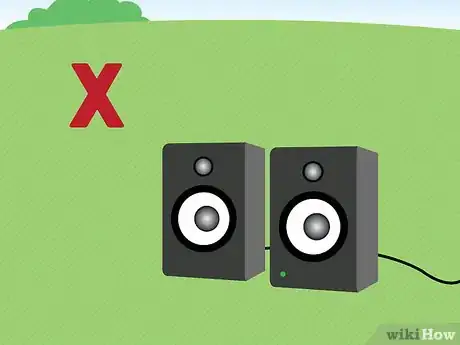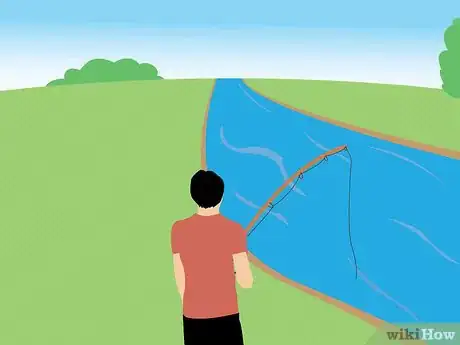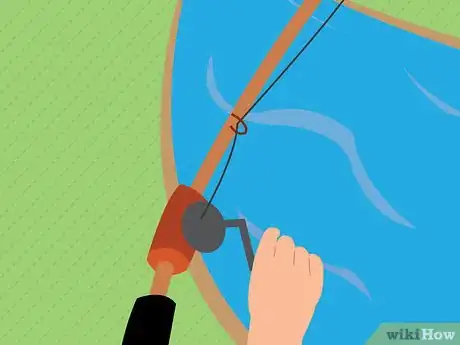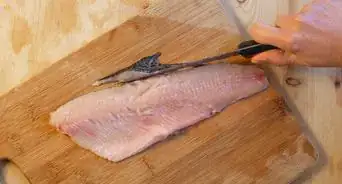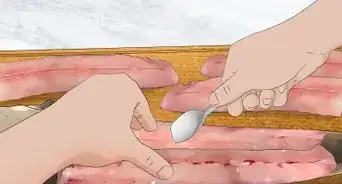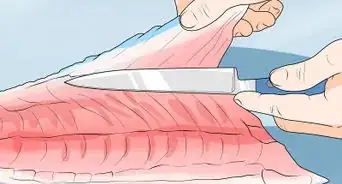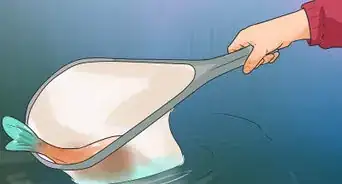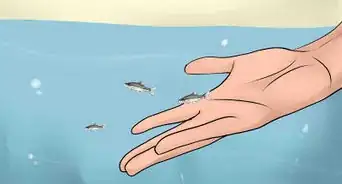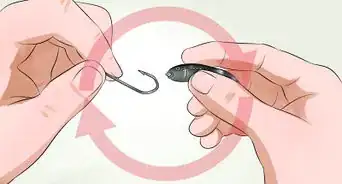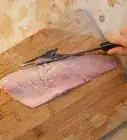This article was co-authored by wikiHow Staff. Our trained team of editors and researchers validate articles for accuracy and comprehensiveness. wikiHow's Content Management Team carefully monitors the work from our editorial staff to ensure that each article is backed by trusted research and meets our high quality standards.
wikiHow marks an article as reader-approved once it receives enough positive feedback. In this case, 81% of readers who voted found the article helpful, earning it our reader-approved status.
This article has been viewed 119,071 times.
Learn more...
The exhilaration of battling with a monster sized catfish is an amazing experience that’s hard to match. These fish can grow to enormous sizes, like the Mekong giant catfish which can get up to 650 pounds (300 kilograms). In America, there are three main species of giant catfish and include the channel catfish, the flathead catfish, and the blue catfish. The largest of the three is the blue catfish, and can weigh in at over 100 pounds (45 kilograms). Because these beasts can get to such enormous sizes, catching them is very different than the majority of regular sized freshwater fish. However, with the right approach and strategy, you’ll be able to catch monster catfish in no time.
Steps
Choosing the Right Equipment
-
1Use large chunks of native fish or entire fish for bait. You want to make sure that you don’t use artificial lures, or smaller bait like prawns. Catfish require bait from their natural habitat, so you should choose a freshwater fish that swim in the same rivers. Using bait like chicken livers or other species of fish may work, but they are not as consistent.[1]
-
2Pick a durable rod that can flex and is long enough to carry the load of a large fish. Stiff graphite rods are not suitable for catching catfish because they do not flex and bend enough, which could cause it to crack or break. Instead, choose either an e-glass or composite rod that is 7 - 12 feet long, because the added length will allow you to bare a higher load, and the flexibility of those rods will absorb some of the fight from the fish and the river's current. You’ll be struggling with the catfish who is at the bottom of the river and these properties are crucial so your rod won't break.
- A longer rod will also allow you to cast out further, which may be required when boat fishing or fishing in a deeper lake or river.
Advertisement -
3Select a a reel with enough cranking power in order to pull in a monster catfish. A large, round, conventional reel will do, but it must have a good drag system and large line capacity if you want to catch the biggest fish. Because you will likely be fishing in a river or other source of water that has a current, a good drag system will allow your bait to float with the current from where you cast it., and the line capacity will give you enough fishing line to accommodate it.
- Use 20 to 30 pound test monofilament line so it won’t break under pressure.
- Use a slip bobber ring for your hook because they are the best for catching bottom dwellers like the catfish. Slip bobber rings have three curved hooks so when the catfish takes the bait it will ensure that he won't tear away, harming the fish and losing your prize!
-
4Wear high rubber boots and comfortable clothes. You’re going to be out in muddy water, and depending on the weather conditions, it could get very cold. When you fish for giant catfish you should wear comfortable clothes for the long haul.
- Because you’re shoes are likely to get wet, wear rubber boots to avoid trench foot, a dangerous condition one can contract from having their feet submerged in cold water over prolonged periods of time. [4]
Picking the Right Location
-
1Fish in a state where catfish are plentiful and legal for game fishing. These bottom dwellers are native to the main channels and tributaries of Ohio, Missouri, and Mississippi.[5] They can also be found in states like Arkansas, Louisiana, and Ohio. In some states like Alabama, catfish are non-game fish, which means that you can’t fish them for sport. Check with your state to see the legal status of catfish or you may be fined.
-
2Choose an area off a main river where catfish usually dwell. Some areas along the river may attract more catfish like the mouth of a tributary off a main river, or a smaller channel. You should also look for inside river bends, as the current is weaker there and catfish prefer to swim in those areas.
- If you are fishing in a lake, you can use sonar to detect sunken island, humps, or hills, as these are prime locations for catfish to feed.
- Choosing a location that has a depth that is similar to how deep your baitfish swims is a good way to trick catfish into biting.
-
3Locate an environment that catfish prefer, like areas with cover or along a rocky coast. While location is important to finding the where catfish may be, you also need to identify suitable environments. Catfish prefer thick cover, like trees that dip into the river, or aquatic vegetation like lily pads or log rafts.
- Warm and humid places are a prime habitat for flatheads.
- Their love of food makes catfish a pretty predictable predator. Think about where its food source would be and try fishing there.
Catching the Catfish
-
1Choose the right time and right season to fish your species of catfish. Different catfish are more active during different seasons. In order to optimize your effectiveness, choose the proper season for the species that is native to your local area.
- Fish just before or after sunset, as catfish will usually be feeding during those times.
- The best time to fish for the largest catfish in the U.S., the blue catfish, you should try to fish during the winter and the spring. [6]
- Flathead and channel catfish are more likely to be found in the hot summer.
-
2Don't make a lot of noise while you fish. Catfish have the ability to hear you by sensing the audio waves produced by sound. If you are making a lot of noise or sloshing around in the river, it might swim away. [7]
- Limit conversation if you are fishing with someone else, or keep your voices very low.
- Avoid playing music while fishing for catfish.
-
3Select and practice a suitable fishing technique while using multiple rods. There are several different ways you can fish for catfish. You can jug fish, which means you will cast a number of jugs that act as floats, with fishing line attached underneath or you can try more traditional methods like shore fishing or boat fishing.
- Make sure to check your bait if the current is fairly strong. It’s possible that the water can wash your bait off your line.
-
4Hold onto the reel and prepare for the power of a monster fish! Once you hook a catfish, make sure that you leave enough slack for it to fully get hooked, but once it is you need to hold onto your reel tightly. Catfish are incredibly strong fish, and can easily pull your rod from your hands if you aren’t paying attention.
- Work the reel up in a smooth motion to bring the catfish closer to you gradually. You want to make sure to sink the hook into it's mouth and not yank it away.
- Allow the catfish to tire itself out, and make sure to use the current to your advantage if it is trying to swim upstream. You can allow your line to go out further if it means making the catfish tired, and thus easier to reel in.
- If you are battling with a catfish for a long period of time, make sure that there is no slack on your line because it gives it the opportunity to wrestle loose. As long as your hook is sunk into its mouth, you should be able to reel it in eventually.
Community Q&A
-
QuestionDo some catfish spines contain venom?
 Community AnswerYes, some catfish do have venom in the sharp, bony spines on the edges of their dorsal and pectoral fins, so be very careful when handling them.
Community AnswerYes, some catfish do have venom in the sharp, bony spines on the edges of their dorsal and pectoral fins, so be very careful when handling them. -
QuestionWhat set up should I use for river fishing?
 Community AnswerTake a 50lb braided main line with a swivel at the end and Palomar tie a 3 way swivel. Next, tie a clinch knot with 8" to 12" of 10lb mono leader line tied to one of the two open loops on the swivel. Tie a 1/4 oz weight with a clinch knot at the end. Lastly, tie a Trilene knot to the last swivel loop with 20lb mono 12"-24" in length, tie size 1, 1/0-6/0 (depending on size fish your looking to catch) at the very end of your last leader line with a Trilene knot. Bait, cast and wait for the fish to nibble. I persoanlly use a straight 50lb braid with a 1/4oz weight at the very end. 12" above the weight I tie a double over hand knot to alolow a loop. Hook goes on with a palomar knot.
Community AnswerTake a 50lb braided main line with a swivel at the end and Palomar tie a 3 way swivel. Next, tie a clinch knot with 8" to 12" of 10lb mono leader line tied to one of the two open loops on the swivel. Tie a 1/4 oz weight with a clinch knot at the end. Lastly, tie a Trilene knot to the last swivel loop with 20lb mono 12"-24" in length, tie size 1, 1/0-6/0 (depending on size fish your looking to catch) at the very end of your last leader line with a Trilene knot. Bait, cast and wait for the fish to nibble. I persoanlly use a straight 50lb braid with a 1/4oz weight at the very end. 12" above the weight I tie a double over hand knot to alolow a loop. Hook goes on with a palomar knot.
Warnings
- Many catfish have spines on their side fins, so be careful when handling them.⧼thumbs_response⧽
- Don't fall into a river or lake because you're battling so hard with a monster catfish. If it's too much for you to handle just cut the line.⧼thumbs_response⧽
References
- ↑ http://www.catfishedge.com/best-catfish-bait/
- ↑ http://www.outdoorlife.com/blogs/gone-fishin/2014/05/new-tackle-techniques-and-baits-catch-biggest-catfish-your-life
- ↑ https://www.gameandfishmag.com/editorial/fishing_catfish-fishing_gf_aa076502a/245218
- ↑ http://www.ncbi.nlm.nih.gov/pmc/articles/PMC1934122/
- ↑ http://www.chesapeakebay.net/fieldguide/critter/blue_catfish
- ↑ http://www.catfishedge.com/best-time-catch-catfish/
- ↑ https://www.gameandfishmag.com/editorial/fishing_catfish-fishing_gf_aa076502a/245218
